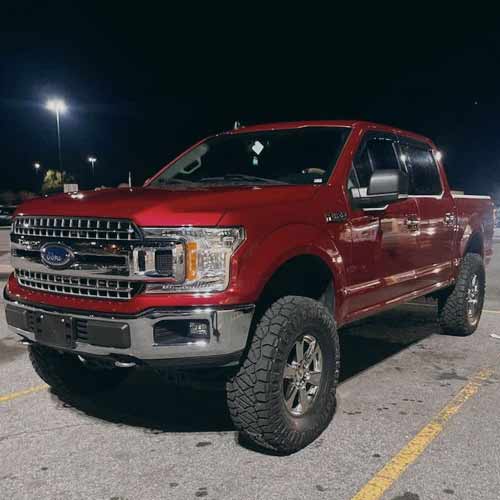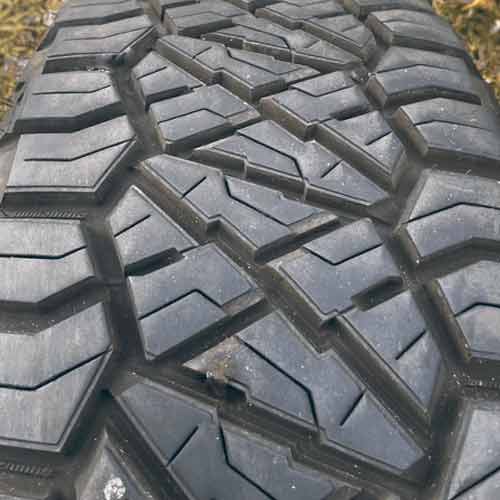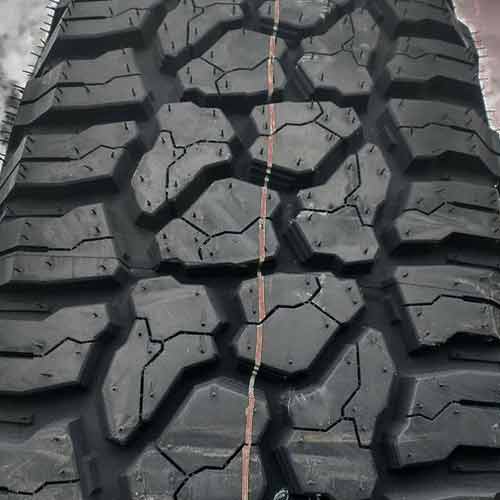In the world of hybrid tires, the aggressive Falken Wildpeak RT finally meets the robust Nitto Ridge Grappler. With distinct strengths and unique capabilities, I unravel the details to help you find the perfect match for your adventures. Let’s get started.

Key Takeaway
Overall, the Falken Wildpeak RT excels in:
- Wet Performance: Where, it offers better water evacuation.
- Winter Conditions: Thanks to its more flexible rubber composition.
- Muddy Trails: With spacious design and deeper tread depth.
- Sandy Dunes: With a softer compound and optimized sidewall lugs.
On the other hand, the Nitto Ridge Grappler excels in:
- Dry Performance: Providing superior directional and lateral grip.
- Noise Dampening: Thanks to its variable pitch technology.
- Rocky Terrains: Due to its robust tread design and durable construction.
- Off-Road Traction: With its dual sidewall design and aggressive tread pattern.
Tread Construction
The Nitto Ridge Grappler is one of the best looking tires out there in my personal opinion.

Its tread is prominently voided up by X shaped grooves, interlinking outer circumferential channels together.
These grooves are formed by 4 triangular blocks in the middle, featuring a lot of biting edges.
They have saw-toothed edges, notches, and good enough linear siping.
Moreover, they also feature reinforced foundations, meaning these lugs are sitting on a stiffer secondary rubber layer, adding to the tire’s on-road stability.
Moving towards edges, you get very squared-off shoulder blocks here, with minimal tread features (as they only have linear sipes).
Though they offer prominent mud scoops, and thicker sidewall lugs in comparison.
They actually come with dual sidewall designs, so its up to you, which side you want to show out.
On the other hand, the Falken Wildpeak RT offers just as aggressive symmetrical tread design.

Now just like the Nitto, this tire also features prominent circumferential grooves separating the shoulder ribs from the middle section.
The middle of the tire is equipped with independent blocks that interlock, allowing the circumferential grooves on each side to connect, thereby aiding in the effective expulsion of mud and dirt.
These while lacking notches, are rich in offset and stepped edges, offering excellent traction.
Additionally, they offer well-designed, interlocking sipes, which further enhance their gripping ability, especially in wet conditions.
Moving towards shoulders, you get elongated lugs there, with prominent mud scoops, and thicker siping on them.
Furthermore, these lugs seamlessly integrate with the sidewall lugs, which, although not as thick as those on the Ridge Grappler, cover a more extensive bead area, contributing to the tire’s overall robustness and durability.
Sizes Variations
The Nitto Ridge Grappler offers 98 total sizes, in 16 to 24 inches, with following specs:
- Total sizes: 98.
- Load range: SL, XL, D, E and F.
- Speed ratings: Only T and Q
- Weight range : 36 lbs to 91 lbs
- Tread depth range: 13/32″ to 18/32″ (Most common: 16.4/32″)
- UTQG: 500 A B (on non-LT sizes).
- Sizes have no mileage warranty.
On the other hand, the Falken Wildpeak RT comes in 16 to 22 inches rims, with following specs.
- Total sizes: 49.
- Speed rating: Only R is available.
- Load rating: C, D, E and F.
- Weight range: 50 to 94 lbs.
- Tread depth range: 16 to 20/32″.
- Treadwear warranty: 50k miles on all sizes.
- UTQG: 500 A B (For non-LT sizes).
- Only available in black letter sidewall
- 3-ply sidewalls on LT, while 2-ply on P-metric sizes, same as Nitto Ridge.
Both tires offer LT, P, Euro-metric, and flotation sizes, and do not come with 3 peak mountain snowflake ratings.
But wait, do you know how to read tire sizes? Well learn all about tire sizes here (a quick read).
Overall Dry Performance
Understanding the dry performance of all-terrain tires requires a detailed examination of their longitudinal grip and cornering capabilities. Let’s see how both tires performed in each of these.
Directional Grip
The term “directional grip” refers to the traction a tire maintains while moving in a straight line, and is measured by tire’s braking abilities.
This grip is crucial as the tire’s central tread area forms the primary contact with the road, with most weight on it, concentrated there.
Now, here, the Nitto Ridge Grappler gets to be slightly better, due to its compact lug formation, enabling superior rubber-to-road contact.
Additionally, its shallower tread depth, with lugs having reinforced foundations, enhances the on-center feel. This means that during high-speed cornering, the tire swiftly realigns itself, enhancing stability and control.
On the other side, the Falken Wildpeak RT lacks, primarily due to its relatively much greater weight, and pliant rubber composition.
Both of these elements basically contribute to its greater momentum inertia, making tire harder to stop, affecting braking distances.
Lateral Grip and Handling
Lateral traction, or the tire’s sideways grip, is predominantly influenced by the tire’s shoulders and sidewalls, as the weight shifts to the opposite side of the tire’s direction, pressing these edges (more) against the road.
So the design of the tread edges is super important for good lateral grip.
And here again, the Nitto Ridge Grappler takes the cake with its chunky, squared-off shoulder lugs. They’re like little grip magnets, giving you more contact with the road and better stability.
But there’s more. Since the tire offers better directional grip (discussed in above section), it allows for quicker corner entry, (as one has to slow down, entering a turn).
Meanwhile, the Wildpeak RT, with its longer stopping time, isn’t as quick on the turns, leading to overall slower handling lap times, as seen on tests.
Side Note:
Noise Reduction
Noise in tires usually comes from air hitting around the tread.
And since both these tires have pretty wide grooves, they are not “quiet” by any means, as there’s a lot of space for air to bounce around and create noise.
Which reminds me, do check out this: https://tiredriver.com/are-all-terrain-tires-noisy/
Yet still, Nitto Ridge Grappler provides you with a more silent ride in comparison, if we’re splitting hairs. This is due to the tire’s better pitch sequencing, which it calls “variable pitch technology.”
This fancy term means that the noise from the lugs creates different tones that don’t all blend together. This mismatch of sounds actually ends up reducing the overall noise you hear.
With it the noise hitting on lugs create different tones, and don’t sync up together, and noise is dampened that way.
The Falken Wildpeak RT tries to tackle noise in a similar way, but it doesn’t quite nail it. The problem is its groove resonance. Basically, its rubber is very, you can say, reflective of sound waves.
So the noise bounces off the tread more, making it a louder, relatively.
Winter Performance
When it comes to tackling snowy conditions, rugged-terrain tires aren’t always the first choice. This is mainly because they’re built for heavier vehicles and tough terrains, not necessarily for the slippery, cold world of winter.
So it makes sense why almost all of them, including these two here, lack the 3 Peak Mountain Snowflake (3PMSF) rating.
This rating is a big deal, because it shows tires are flexible enough to provide traction, without getting frozen. So without this rating, these tires tend to struggle with acceleration and grip, especially when the mercury drops below 45°F or (7°C).
Though out of both boys, the Wildpeak RT gets a bit of an edge, as its rubber composition is comparatively more flexible, which means it less susceptible to stiffing up with freezing temperatures.
Moreover, it also features better siping and tread elements, which are designed for snow traction.
Take its shoulder lugs, for instance. They’re equipped with thick, full-depth slits along the edges. These slits are like little snow catchers, trapping snow particles within them, providing traction.
Why does this matter? Well, because snow-on-snow contact actually increases traction, these particles don’t stick too well on rubber.
So, while neither tire is a winter wonder, the Falken RT shows a bit more promise in snowy settings, thanks to its slightly more winter-friendly design.
Wet Performance
Truth be told, both tires could honestly do better with their siping (design), which is the main key for wet traction. Though comparing both, the Wildpeak RT manages to edge out just a bit ahead.
Let me explain how.
So, it’s all about the grooves and sipes. Grooves are the big channels that help fend off hydroplaning, and both tires are pretty solid in this department. They move majority of water out of the way.
But, there’s always some water that sticks around, slipping under the tread blocks. And that’s where sipes come into play.
Think of sipes as tiny slits that open up when the tire rolls over the road, sucking up the remaining moisture and drying the surface.
The Nitto Ridge Grappler, though, kinda drops the ball with its siping. Sure, it’s got a bunch of them, but their straight layout make them prone to stiffing, especially when you’re taking sharp corners.
In other words, they don’t open up as they should, so they’re not as good at soaking up water. Plus, the tire’s “relatively” hard composition and low silica content don’t help, making the sipes even more rigid.
On the other side, the Wildpeak RT offers a more pliable rubber, with better interlocking siping structures, allowing for superior water absorption in comparison.
Plus, with deeper treads, it’s already moving more water out of the way (through grooves), so there’s less left for the sipes to deal with.
Rugged Terrain Performance
Off-road is where these A/T tires are worth it. But let’s be more specific, and check out each of the (main) terrain types, and tires’ performance on them.
On Rocks
When tackling rocky terrains, tires need to grip well both vertically and horizontally, and they’ve got to be tough. So it makes sense why in this scenario, the Ridge Grappler is standing out.
In fact, I rated these boys best for rocks (in A/T category), and added it to my list of best all-terrain tires. Check the list here: https://tiredriver.com/best-all-terrain-tires/
So what makes Nitto so good here?
Well, the tire provides very powerful X-shaped voids, which act as in-groove notches, chewing on rocks from all directions.
Sure Wildpeak RT also features big groove mouth, they just don’t have the off-sets, and sharp triangular edges, you see on its counterpart.
Meaning, the tire doesn’t quite match up in overall traction, which is particularly noticeable at lower (tire’s) air pressures.
Speaking of which, now, the Ridge Grappler’s dual sidewall design, featuring thick lugs on each side, really comes into play here, providing excellent grabbing power on rocky surfaces.
Actually one of the tire’s sides (the more aggressive one), is really optimized for climbing rocks, providing relatively better grip.
On Muddy Trails
Dealing with mud is all about having wide grooves and the ability to clean themselves out. This design helps get rid of mud quickly, providing grip and stability.
Now, the Falken RT has a bit of an advantage in muddy conditions, thanks to its less crowded lug design, especially in the middle tread area, allowing better mud clearance.
Plus, its deeper tread depth helps shift that thick, sticky clay, while its stepped edges break up the particles, making them easier to flow out.
On the other side, the Ridge Grappler isn’t lacking too far behind, as it’s got some great interconnected (X-shaped) tread voids.
Though they’re just not as wide/efficient, compared to Wildpeak here.
On Sandy Dunes
Now, when it comes to sand, reducing air pressure in the tires can make a big difference, as it helps the tire to “float” over this soft surface. Though tread features also play a crucial role in “floating” of a tire.
And here, the Falken RT takes the lead, with its softer compound, especially with lowered air pressure, allowing its lugs to conform better to the sandy surface, providing more grip.
Additionally, the design of the Wildpeak RT’s sidewall lugs is more optimized for sand traction.
Basically, these lugs cover more of the sidewall compared to the Ridge Grappler, which translates to better rubber-to-sand contact at lower pressures.
For better understand, I’d recommend checking out: https://tiredriver.com/are-all-terrain-tires-good-on-sand/
Road Comfort
A tire’s ability to smooth out those annoying bumps and dips in the road comes down to its design and the materials used in the tread.
The Wildpeak RT shines in this aspect. Thanks to its softer rubber composition, it’s more adept at absorbing those little jolts and jiggles from the road. Plus, with a tread depth of up to 20/32″, it has more cushion to dampen vibrations.
Though sizes with DuraSpec technology, aren’t so great in providing as much road smoothness, as they come with high turn-up on polyester casings.
For Your Info: A high turn-up in these sidewalls means that the plies extend higher up, adding to the tire’s overall rigidity.
Tread Life and Fuel Economy
When talking about fuel efficiency and how long a tire lasts, it’s all about rolling resistance and heat. And here, the weight, tread design, and rubber composition of the tire play main roles.
Now, with the Falken RT, its softer rubber and heavier build generates greater rolling resistance, guzzling more fuel.
Basically both these factors bend the lugs (on tread) more, wasting energy in the form of heat, which of course isn’t great for your gas mileage.
But when it comes to how long the tire lasts, the Wildpeak RT is pretty much neck-and-neck with the Ridge Grappler.
This durability comes down to two key factors. Firstly, Falken’s got a deeper tread, so it takes longer to wear down to the legal limit of 2/32″.
Secondly, its lugs have these reinforced foundations (like Nitto’s tire), that help keep rolling resistance in check, even with that deeper tread.
Take Home Points
So overall, although I’d recommend reading the full comparison for a detailed understanding, here’s a concise summary for those in a hurry.
On-road, the Nitto’s tire provides better dry performance with its superior directional and lateral grip, enhancing stability and control, especially during high-speed cornering.
While Wildpeak does better in wet and winter conditions, thanks to its effective siping and deeper tread depth, leading to better water evacuation and absorption, and softer rubber, providing better grip on snow.
Other than this, the Ridge Grappler provides a relatively quieter ride, with its well designed tread pattern, and it rocks on rocks.
On the other side, the Wildpeak RT provides better road smoothness, and is better suited for muddy trails and sandy dunes.